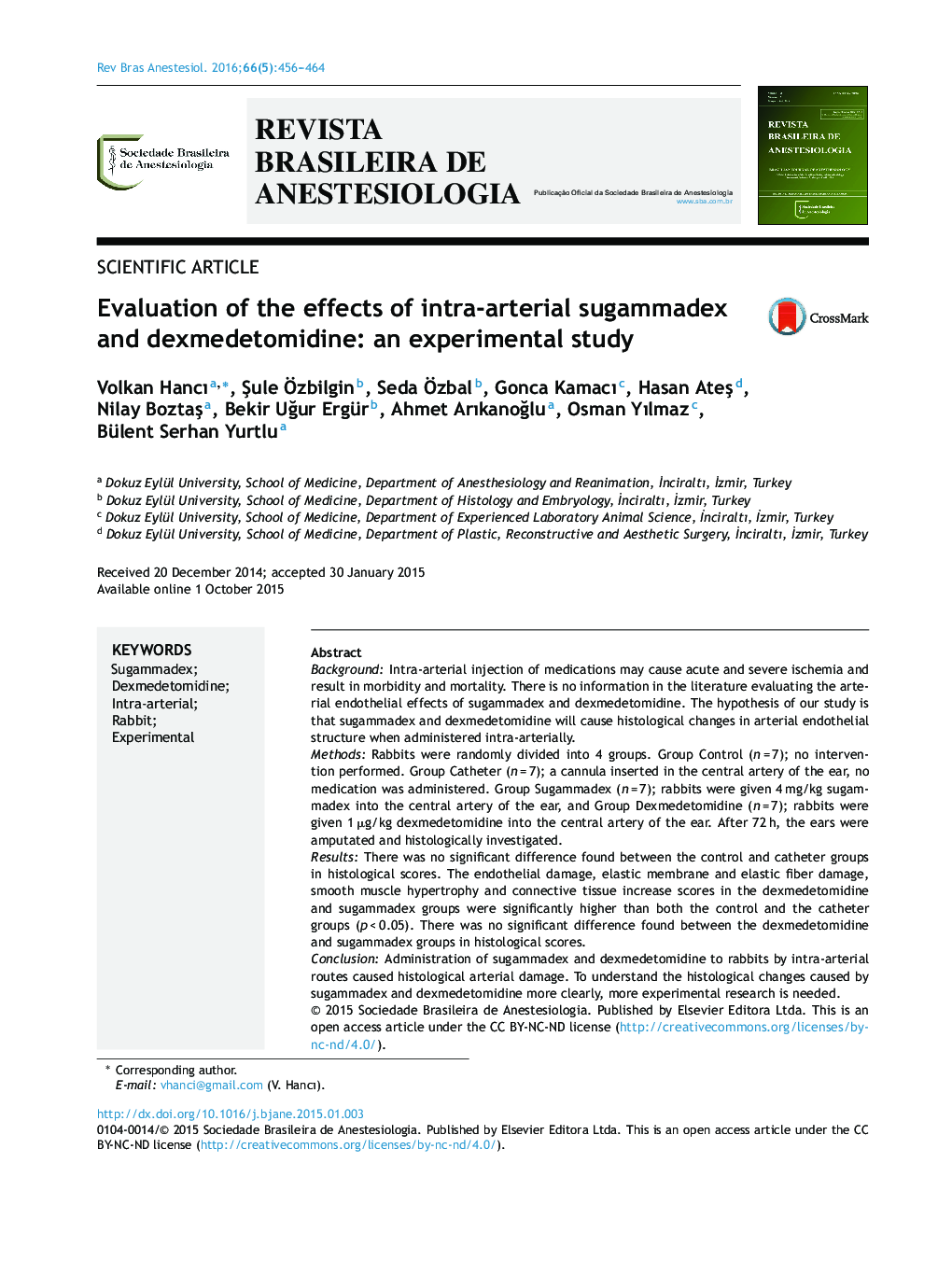| کد مقاله | کد نشریه | سال انتشار | مقاله انگلیسی | نسخه تمام متن |
|---|---|---|---|---|
| 2750058 | 1567296 | 2016 | 9 صفحه PDF | دانلود رایگان |
BackgroundIntra-arterial injection of medications may cause acute and severe ischemia and result in morbidity and mortality. There is no information in the literature evaluating the arterial endothelial effects of sugammadex and dexmedetomidine. The hypothesis of our study is that sugammadex and dexmedetomidine will cause histological changes in arterial endothelial structure when administered intra-arterially.MethodsRabbits were randomly divided into 4 groups. Group Control (n = 7); no intervention performed. Group Catheter (n = 7); a cannula inserted in the central artery of the ear, no medication was administered. Group Sugammadex (n = 7); rabbits were given 4 mg/kg sugammadex into the central artery of the ear, and Group Dexmedetomidine (n = 7); rabbits were given 1 μg/kg dexmedetomidine into the central artery of the ear. After 72 h, the ears were amputated and histologically investigated.ResultsThere was no significant difference found between the control and catheter groups in histological scores. The endothelial damage, elastic membrane and elastic fiber damage, smooth muscle hypertrophy and connective tissue increase scores in the dexmedetomidine and sugammadex groups were significantly higher than both the control and the catheter groups (p < 0.05). There was no significant difference found between the dexmedetomidine and sugammadex groups in histological scores.ConclusionAdministration of sugammadex and dexmedetomidine to rabbits by intra-arterial routes caused histological arterial damage. To understand the histological changes caused by sugammadex and dexmedetomidine more clearly, more experimental research is needed.
ResumoJustificativaA injeção intra-arterial de medicamentos pode causar isquemia aguda e grave e resultar em morbidade e mortalidade. Não há informações na literatura avaliando os efeitos endoteliais arteriais de sugamadex e dexmedetomidina. A hipótese de nosso estudo foi que dexmedetomidina e sugamadex causariam alterações histológicas na estrutura endotelial arterial quando administrados por via intra-arterial.MétodoOs coelhos foram randomicamente divididos em quatro grupos: grupo controle (n = 7), sem intervenção realizada; grupo cateter (n = 7), uma cânula foi inserida na artéria central da orelha e medicamentos não foram administrados; grupo sugamadex (n = 7), os coelhos receberam 4 mg/kg de sugamadex na artéria central da orelha; grupo dexmedetomidina (n = 7), os coelhos receberam 1 μg/kg de dexmedetomidina na artéria central da orelha. Após 72 horas, as orelhas foram amputadas e histologicamente examinadas.ResultadosNão houve diferença significativa entre os grupos controle e cateter referente aos escores histológicos. Os escores do dano causado ao endotélio e à membrana e fibra elásticas, da hipertrofia do músculo liso e do aumento do tecido conjuntivo foram significativamente maiores nos grupos dexmedetomidina e sugamadex que em ambos os grupos controle e cateter (p < 0,05). Não houve diferença significativa entre os grupos dexmedetomidina e sugamadex nos escores histológicos.ConclusãoA administração de sugamadex e dexmedetomidina a coelhos por via intra-arterial causou danos arteriais histológicos. Para entender as alterações histológicas causadas por sugamadex e dexmedetomidina com mais clareza, estudos experimentais adicionais são necessários.
Journal: Brazilian Journal of Anesthesiology (English Edition) - Volume 66, Issue 5, September–October 2016, Pages 456–464
